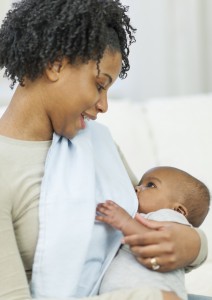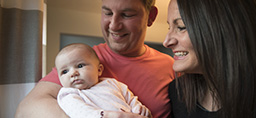
After she gave birth to son, Ezra, in 2012, staff focused on the baby and the busy-after-birth tasks at hand.
After her second son’s birth in December, the focus was on bonding and breastfeeding. Dyer said she appreciated quiet time as mom and baby Abram became acquainted.
“It was nice things weren’t rushed,” the Byron Center resident said. “It wasn’t like they had to quick weigh him, give him shots, give him a bath. It was real nice just to have that time, to try to breastfeed and not try to rush that. Just being able to take your time was really beneficial.”
Although breastfeeding isn’t mandatory, nor is quiet time for that matter, Dyer said she appreciated Butterworth Hospital’s new baby-friendly atmosphere.
During the past three years, Spectrum Health women’s and infant services at Butterworth Hospital and Spectrum Health United Hospital transitioned to the baby-friendly model of care, which augments the importance of breastfeeding, quiet time and uninterrupted skin-to-skin bonding time between mother and child.
Last fall, Butterworth Hospital and United Hospital received baby friendly designation from Baby Friendly USA, the accrediting body of the Baby-Friendly Hospital Initiative in the states. The initiative is a global effort of the World Health Organization and UNICEF.
Only 7 percent of hospitals in the country have earned the designation, according to Laurel Jander, RN, nurse manager for women’s and children’s services, who, along with the women and infant leadership team, helped spearhead the local initiative.
The Baby Friendly Hospital Initiative is a global effort to promote and support breastfeeding. Since its launch in 1991, more than 150 countries have implemented the initiative.
Dyer said she noticed a big difference. The silence shimmered golden.
“My favorite positive change from when I had Ezra to when I had Abram was having an hour of skin-to-skin time after Abram was born,” the Byron Center resident said. “This uninterrupted bonding time was very special.”
Dyer said breastfeeding was paramount after Abram’s birth.
“My nurse, Amanda Welniak, was exceedingly supportive and knowledgeable in helping me breastfeed for the first time,” she continued. “She took the time to ensure Abram had a good latch and didn’t seem preoccupied with other duties.”
Dyer said nurses on the postpartum recovery floor routinely asked how breastfeeding was going.
“If I was experiencing any pain, they would help me,” Dyer said. “I didn’t receive nearly as much breastfeeding encouragement and assistance when I had my first son, Ezra, two years prior.”
Jander said the baby-friendly designation involves rigorous criteria based on 10 steps, all of which are evidence-based. Patients are educated about skin-to-skin, breastfeeding, rooming in and pacifier use.
“Once patients are educated, we then honor their choices,” Jander said. “It is not about making moms breastfeed. It is about fully supporting every mom in the informed choice she makes.”
The moments after birth offer precious opportunities for cuddling and learning about one another.
“This time is important so mom can bond with baby and baby can bond with mom,” Jander said. “Mom can learn her infant’s feeding cues, which can be very subtle. This time together builds mom’s confident in caring for her baby when she goes home.”
Jander said when babies are separated from their moms, they expend a lot of energy feeling anxious. And babies need all the energy they have to learn to breastfeed and grow strong.
Instead of a baby being taken to the nursery, his or her comfort zone is next to mom.
And that, according to Jander, is right where baby belongs.
 /a>
/a>
 /a>
/a>
 /a>
/a>